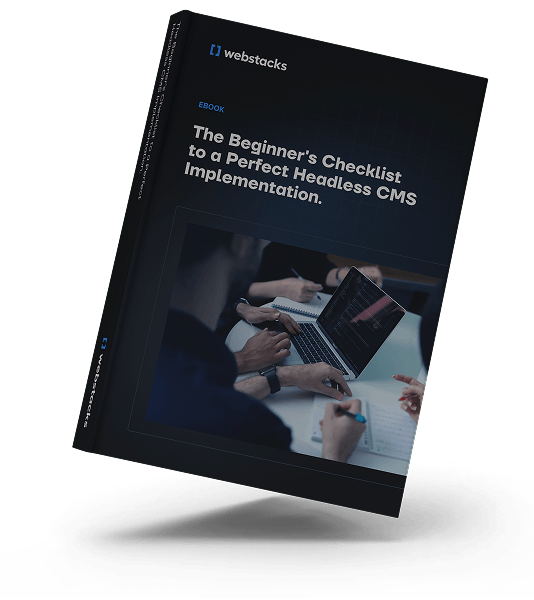At Webstacks, we work closely with high-growth B2B companies to build scalable web experiences that support fast-moving marketing and product teams. Choosing the right content management system is an important part of that process. And with options like Contentful and Builder.io, it’s not always a straightforward decision.
Both platforms offer modern, headless architecture with distinct advantages depending on your team’s structure, technical resources, and content goals.
Both platforms offer modern, headless architecture with distinct advantages depending on your team's structure, technical resources, and content goals.
The core trade-off: Contentful prioritizes structured governance, content consistency, and long-term scalability—ideal for teams managing complex operations across channels, regions, and brands. Builder.io prioritizes visual agility, marketing autonomy, and campaign velocity—ideal for teams that need to launch, test, and iterate without developer dependencies.
The right choice isn't about which platform has more features. It's about which operational model matches how your team actually works. This comparison explores both platforms through the lens of real-world use cases to help you identify the best fit.
Contentful vs Builder.io: A Brief Overview
When evaluating CMS platforms, B2B marketing and digital leaders often look for solutions that empower cross-functional teams, not just developers or designers.
If you're moving off of WordPress or Webflow, both Builder.io and Contentful offer major improvements in speed and flexibility.
Contentful is one of the most widely adopted headless CMS platforms on the market. It’s trusted by teams looking to deliver content across channels with speed and consistency.
While it’s known for its developer tools and flexible APIs, it’s also a powerful platform for marketing and content teams.
With structured content models, localization support, and integrations across the martech stack, Contentful helps teams launch and scale digital experiences with operational control and brand consistency.

Builder.io, on the other hand, focuses on visual editing and speed to market.
It’s designed to give SaaS marketers and designers more autonomy with a drag-and-drop interface that doesn’t sacrifice the benefits of a headless architecture. Builder.io makes it easy to create and update content visually.
It’s ideal for campaign agility, iterative testing, and dynamic landing pages.
Here’s a high-level comparison to help you frame the decision:

Top Use Case Comparisons
B2B organizations have different priorities based on their industry, growth stage, and priorities.
That’s why it helps to compare Contentful and Builder.io across their top use cases to help you understand how each can solve your biggest challenges.
1. Empowering Teams to Move Faster Without Developer Bottlenecks
One of the most common frustrations we hear from B2B marketing leaders is how often teams are blocked by development resources for even the simplest content updates.
When marketers rely on developers to launch a landing page or adjust a headline, agility suffers and so do campaign results.
Builder.io is designed to solve this exact issue.
Its drag-and-drop interface allows marketers and designers to create and modify pages independently, without needing to loop in engineering.
For teams running high volumes of experiments or launching new campaigns weekly, this can dramatically increase output and reduce time-to-market.
Contentful takes a more structured approach, but that doesn’t mean marketers are left out.
With predefined templates and components built by developers, marketing teams can populate and update content in a controlled environment to maintain consistency.
2. Launching Campaigns Quickly
In high-growth environments, opportunities don’t wait for development cycles.
Marketing teams need the ability to launch, iterate, and optimize campaigns without getting bogged down by traditional CMS limitations.
Builder.io’s visual editor is purpose-built for campaign agility. Marketing teams can spin up pages, swap content, test variations, and ship changes quickly.
This enables continuous iteration based on performance data, which is perfect for campaign-driven organizations with a strong experimentation culture.
Contentful supports campaign velocity in a different way.
By using a structured content model, marketing teams can reuse content blocks and templates to reduce friction in the publishing process. Once the foundational system is in place, Contentful enables speed at scale.
Choosing between them comes down to how your campaigns are executed. For high-frequency, fast-turnaround initiatives, Builder.io offers unmatched speed. For sustained velocity across a broad ecosystem of channels and teams, Contentful provides a scalable foundation.
3. Delivering Personalization and Localization at Scale
As B2B brands expand into new markets and tailor messaging for specific segments, managing content variations becomes increasingly complex.
Marketing teams need the ability to personalize content by audience and localize it by region.
Contentful is suited for global content operations, especially when structure and governance are a priority. It enables marketing teams to:
- Manage multi-language versions and regional content with precision
- Reuse shared content components across regions and brands
- Maintain consistency while allowing targeted variation
- Support complex localization workflows with structured relationships between content types
Builder.io brings a more visual approach to localization and personalization, allowing you to:
- Quickly create multiple versions of a page using a drag-and-drop editor
- Customize copy, imagery, and layout for different audiences or regions
- Iterate and launch variations quickly without development dependencies
If your strategy demands structured control over localization and long-term content governance, Contentful provides a good framework. For teams prioritizing speed, flexibility, and visual adaptability, Builder.io offers a compelling alternative.
We've worked with clients using both approaches and often recommend the platform that aligns best with your team's workflow maturity, regional reach, and campaign velocity.
Learn more by reading how we migrated iTrustCapital’s website from WordPress to Contentful and Gatsby for a seamless content editing experience.
4. Building a Foundation That Scales With You
As teams scale, add brands, expand into new channels, or reorganize workflows, your content platform needs to scale with you.
Contentful is great in enterprise-grade scenarios.
It supports complex content hierarchies, granular user permissions, and a composable architecture that integrates with your broader martech ecosystem. For SaaS teams planning multi-brand rollouts, content syndication, or omnichannel delivery, Contentful offers the infrastructure to scale confidently.
Builder.io is also built for scale but in a way that's especially friendly to marketing and design teams.
It works especially well for organizations using component-based design systems. Developers can register custom components for use in the visual editor, allowing non-technical users to scale content creation without reinventing layouts.
If your organization is growing quickly and anticipating more complexity, Contentful may be the better long-term bet. But if your growth is centered on design system maturity and campaign agility, Builder.io offers scalable simplicity.
5. Giving Stakeholders More Visibility
Whether your priority is maintaining editorial standards or speeding up reviews and approvals, both Contentful and Builder.io give stakeholders the visibility they need. Just with different mechanisms for achieving it.
When website stakeholders can’t see what’s going live, approve content in a timely way, or trust the quality of what’s being published, frustration builds.
Contentful provides guardrails and governance through custom roles, content validations, and approval workflows.
You can set up structured publishing processes, which is especially useful for larger teams where accountability, visibility, and compliance matter.
Builder.io provides a real-time, visual editor that lets stakeholders preview content exactly as it will appear, which reduces guesswork and speeds up review cycles.
For fast-paced teams that prioritize visibility over rigid workflows, this is a good option.
Choose Contentful For Structure, Scale, and Strategic Control
Contentful is a strong choice for B2B SaaS organizations that need to manage complex content operations at scale. If your team is responsible for multiple brands, operates in several regions, or has strict governance needs, Contentful offers the tools and flexibility to support that growth.
Its structured content modeling, support for localization, and granular permissions make it ideal for enterprises with sophisticated publishing needs. Contentful is also a future-proof investment—it integrates well with your broader tech stack, supports composable architectures, and provides the scalability required by organizations with long-term digital transformation goals.
You should choose Contentful if:
- You manage content for 3+ brands or 5+ regional markets
- Your team requires structured approval workflows and role-based permissions
- You have developer resources available for initial content modeling and component setup
- You're integrating with 10+ tools in your martech stack (CRM, marketing automation, analytics)
- You need to deliver content across multiple channels (web, mobile apps, digital signage, IoT)
- Long-term scalability and governance are more important than immediate speed to market
- Your content requires complex relationships and dependencies between content types
- Compliance, legal review, or editorial standards require formal publishing controls
Contentful provides the infrastructure to centralize content operations, maintain consistency at scale, and support composable architectures that evolve with your business.
Choose Builder.io For Speed, Flexibility, and Frontend Agility
Builder.io is ideal when you prioritize speed and visual control. If your team is constantly launching campaigns, testing landing pages, or running experiments, Builder.io allows marketers to execute quickly without engineering bottlenecks.
Builder.io also scales well in design-driven environments. As your library of reusable components grows, so does your team's ability to publish and iterate without starting from scratch. If your marketing strategy emphasizes rapid experimentation and high-velocity campaigns, Builder.io lets you move quickly and stay competitive.
You should choose Builder.io if:
- Marketing teams launch 10+ campaigns per quarter and need to move without developer support
- You have an established design system with reusable components ready to scale
- Developer bottlenecks are slowing campaign execution and experimentation
- Visual editing and real-time preview are critical for your content workflow
- Your strategy emphasizes rapid A/B testing and iterative optimization
- You want to empower designers and marketers to build pages independently
- Speed to market is your primary competitive advantage
- Your team is comfortable with less structured content governance in exchange for agility
Builder.io enables high-velocity marketing teams to execute quickly, test continuously, and scale content production without waiting for engineering resources.
For example, in our project with Solana, we used Builder.io to develop a scalable, developer-centric website that empowered their marketing team to publish and update pages without developer support. This approach allowed them to scale content production for news, reports, and case studies.
Still Exploring the Best CMS for Your Team?
If you're early in your CMS evaluation or still exploring what's out there, it's worth considering other platforms that may better align with your team’s structure, goals, or technical resources.
At Webstacks, we often work with companies that are comparing Contentful and Builder.io—but they’re also evaluating options like:
- Sanity – A developer-first platform with extreme flexibility, ideal for structured content and custom editorial workflows.
- Storyblok – A visual-first CMS with strong localization capabilities and a hybrid approach to content structure.
- DatoCMS – Lightweight and fast to implement, great for teams that want performance without the complexity.
Here are some additional CMS comparison guides to help continue your research:
- Contentful vs Sanity
- Contentful vs DatoCMS
- Builder.io vs Webflow
- Builder.io Alternatives
- Contentful Alternatives
These guides are built from real-world implementation experience and written to help B2B marketing and digital teams choose the right platform, not just the most popular one.
Need help narrowing it down? We’ll help you assess your stack and recommend a CMS aligned with your growth and content ops goals. Talk to our team:
Use a CMS That Enables the Outcomes You Care About
There's no universally "better" platform between Contentful vs Builder.io.
Your decision should be based on technical features and what they allow your team to accomplish. But it helps to partner with a web development agency to get expert insights on which CMS to use.
Webstacks has helped dozens of B2B companies evaluate and implement the right headless CMS.
We bring hands-on experience with both Contentful and Builder.io, and we partner with teams to align the platform with marketing priorities, operational workflows, and long-term scalability.
If you're building a scalable, composable website architecture, we can help you determine which platform will best support your growth goals while keeping your marketing team agile. And through our comprehensive support, we make sure your CMS continues to meet your needs as your business grows.
To make sure your transition to a headless CMS goes smoothly, download our checklist below:





